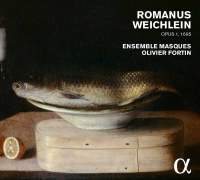Texte paru dans: / Appeared in: |
|
|
Outil de traduction ~ (Très approximatif) |
|
|
Reviewer: Barry
Brenesal My first impression when this album arrived was to wonder why there wasn’t a second disc. It’s listed as “Romanus Weichlein: opus 1 (1695).” From past experience, I know this means 12 sonatas in late stile moderno, with or without the four short pieces offered as an appendix in the original publication. But, no: Only five of the sonatas are offered here, surrounded by ostinato-based works of similar length by a variety of composers who are more or less Weichlein’s contemporaries. This programmatic approach works well, but the album’s cover should have been clearer about its contents, as you get let than half of Weichlein’s Encaenia Musices. Capella Vitalis Berlin (Raumklang 3401) supplies eight of the 12 sonatas, plus the appended works, while Ars Antiqua Austria under Gunar Letzbor’s direction (Pan Classics 10269) supplies all 12 sonatas, minus the appended pieces, on two CDs. I have no quarrels with the performances on this disc. Where I found Olivier Fortin and his Ensemble Masques technically expert, sporting great tone, but sedate and bland in a group of works by Schmelzer (Zig-Zag 334; Fanfare 37:4), here they are more alive to the music’s nuances. Theirs are still relaxed readings, but unlike that Schmelzer release, they really do “take stage” in Weichlein’s often quirky and dramatic sonatas. The opening of the Third Sonata’s second movement, for example, spreads arpeggiated minor chords in this performance like some great bird of night; and the six-eight rhythms in the lower string parts of the Second Sonata’s second movement are pointed precisely, the violins ornamenting suddenly, smartly, overhead. The musicians use both slow and fast vibrato as coloration to good advantage. By contrast, Gunar Letzbor takes the pace sufficiently quicker in most movements with his Ars Antiqua to make ornamentation all but impossible without scrambling. The differences continue down the line. Where Letzbor emphasizes linear energy, Fortin prefers a vertical richness of texture. Neither is done to extremes. Both work. Three of the additional compositions—the Kuhnau, Pachelbel, and Kerll pieces—are transcriptions for two harpsichords. Their arranger is never mentioned in the liner notes, which may mean Fortin is responsible. I find the results jangly if sonorous, approaching at some distance the remark, once attributed (apocryphally) to Beecham, that a harpsichord “sounds like a pair of skeletons copulating on a tin roof in a hailstorm.” All are ciacconas, though Kuhnau’s Suonata Sesta isn’t labeled as such. I hear nothing in them that requires two keyboards, and would have preferred the results on a single instrument. The other two works, Muffat’s passacaglia and Böhm’s charming capriccio, are performed by Fortin alone, with sound perfectly complementing their fine performance. I really can’t help wishing, however, that Fortin and Ensemble Masques had given us the entirety of Encaenia Musices, with perhaps friends brought in to cover the paired trumpet parts in the First and 12th Sonatas. No slight to Fortin’s harpsichord playing is intended, but these performances of the Weichlein are good enough desire the entire set from his ensemble. | |
|
|
|
|
Cliquez l'un ou l'autre
bouton pour découvrir bien d'autres critiques de CD |
|




